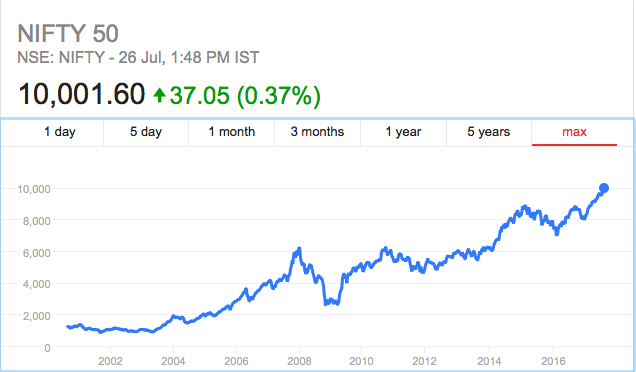So, the Nifty 50 stock market index is at a value of 10,000.
The stock markets are celebrating and so are some investors. There is also a crop of new investors who have just begun their investments in stocks/mutual funds. And then there are others who worry themselves to no end. Of course, not all 5 fingers are alike.
So, how much do we really know about this Nifty 50 index, which everyone is feeling cheery or gloomy about. Let me share some facts.
The Nifty 50 index was started in April 1996 and constitutes 50 companies based on free float market capitalisation and certain other criteria.
Nifty 50’s stocks account for about 63% of the total market capitalisation. To put that into perspective, there are a few thousand listed companies on the stock exchange.
The base of the index is 1000.
So, it took over 21 years to reach the current level. I am sure some of you including me don’t have investing experience of those many years.
Source: Google
The Nifty 50 index has had 173 changes since its inception. By changes I mean, companies being included or excluded from the index. Over 100 companies have come in or gone out over this period. That’s roughly 8 to 9 transactions of entry / exit every year.
In terms of turnover, we have a completely new set of companies every 11 odd years. Talk about being dynamic!
One important point you should notice is that the Nifty 50 index value that you see in public domain is based on the price change only. It is a price index. Since the index cannot receive any dividends or bonuses, that gain does not get reflected in the Nifty 50. If you do that, you will have a total returns index.
So, since inception the price index Nifty 50 has delivered close to 11% compounded year on year. However, you can use a thumb rule and add 1.5% to 2% to account for dividends, etc. and hence, you will have about 12.5% to 13% returns year on year, over 21 years.
Note: This does not account for transaction costs, if any.
The next 10000 for the Nifty 50
With economic growth, companies will grow and it will reflect in the stock prices of listed businesses. So, the next 10000 is bound to happen. The question is when? It could be next 5, 10 or 15 years.
As you noticed, several companies move in and move out of the index. Even for the next 10,000, we are likely to see many new companies taking over from the old guards.
How will you identify these investment opportunities and ride them to build your own wealth to meet your goals?
As you can see, the next 10000 will also witness the same topsy turvy ride, bouts of strong volatility, may be another 1999, 2008, 2012 and 2016.
How are you getting ready to stomach this volatility?
Will you prepare yourself or will you choose an advisor to do that for you?
What would Malcolm Gladwell tell you?
Gladwell wrote a book titled “OUTLIERS”, where he examines the factors that contribute to high levels of success.
As per Wikipedia,
Throughout the publication, Gladwell repeatedly mentions the “10,000-Hour Rule”, claiming that the key to achieving world-class expertise in any skill, is, to a large extent, a matter of practising the correct way, for a total of around 10,000 hours.
Ah! The number 10,000.
What will determine success over the next 10000 of your investment journey?
What will your effort and hours look like?
Are you likely to emerge as an expert?
Well, you can, provided you take the right steps, do mindful, deliberate practice and keep company of good friends and advisors.
How do you see yourself over the next 10,000?
Planning to use the Money Master program to prepare for your investment success? Find out more.






I need daily updates on Global stock market as well, which country or economy is good for investments